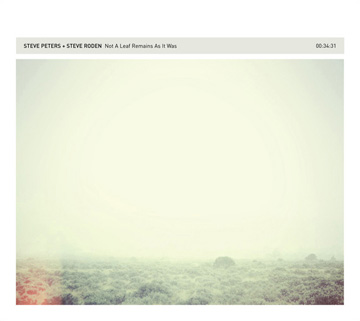
steve peters + steve roden
CD
edition: 1000
12k
2012
- Winds Through Bleak Timber
- Fade Away Within
- Water Veins
- Two Or Three Fireflies
In 1995 Steve Peters and Steve Roden toured as a trio with singer Anna Homler; sometimes they would vocalize behind her, and they liked the way their voices blended together. They then spent about 15 years saying that “someday” they should record a voice-based project together. Aside from the physical distance between them, the problem was always: What would we sing? Neither wanted to write or sing lyrics.
Inspiration came in the form of a book of Japanese jisei – poems allegedly written by monks on their death bed – printed in both English translation and Romanized Japanese. Phonetically pronouncing the Japanese reminded Peters of the technique Roden has used of systematically chopping up the syllables in English texts to transform them into sound poems. Since neither of them speaks Japanese, it seemed like a good place to begin.
The two of them applied for a residency at Jack Straw, a non-profit recording facility in Seattle that gives grants of studio time. They had no exact plans other than they intended to avoid electronic instruments, or directly referencing the poems’ literal meaning, or imitating any Japanese musical idioms or “Zen” stereotypes. Culling some of the poems that made references to sound and noting them on 3×5 cards, Peters and Roden sorted the cards into four groups according to the seasons of the year that the poems represented, divided the cards between them, and taped them to their music stands. They then sang random fragments from the various cards – a word here, a line there, maybe backwards, maybe the English translation. They made no effort to keep the poems intact or retain any of their meaning, instead treating the material simply as phonemes to put in their mouths.
All of the music was improvised in the studio, built up one track at a time. They worked intuitively, with no structural guidelines beyond using the texts. Three days later they emerged from the studio, not quite sure what they had done. After letting the material rest for several months Peters and Roden determined that Doug Haire, who recorded the sessions at Jack Straw, was the obvious choice to do the mixing. The album was completed in the fall of 2011.
12k is known to be a label of understatement and restraint, however, Not A Leaf Remains As It Was is arguably the most hushed and delicate record in the label’s catalog. Every sound on the album’s four tracks, be it the artists’ voices, a pump organ or melodica hangs by a thread, played ever so slightly, with utmost care. Noises, created from turtle shells, leaves, and bells shuffle and flutter, as if they are quietly alive, in the background providing a textural backdrop to the sublime tones and ghostly voices.
- reviews:
Chroniques Electroniques website:
Both Steve Peters and Roden, are far from novices. Their collaborations and their respective achievements are almost inchiffrables. Fond of field recordings and electro-acoustic improvisations, the fifties Steve Peters is a full member of the Seattle Phonographers Union. Steve Roden is younger but an impressive number of releases is also to his credit. Painter and sculptor, his musical talents are mostly in the service of further facilities. Their meeting and rallying for the occasion of Taylor Deupree at 12k is about anything but random. Not A Leaf Remains As It Was is the result of their confinement in a studio in Seattle. The goal was to make an album, “how” and “with what” was decided on the spot, to our delight.
Their collaboration with singer Anna Homler dated from 1995. Even then, they had said it would be good form to create a double album with vocals important. Who was to sing the question remained.
Armed with a book of Japanese poems (jisei) who spoke to them, they now had a working basis. Japanese is a language that can not be improvised with great difficulty, they would have to settle for phonetics. It is therefore of Japanese phonemes which égrainent throughout Not A Leaf Remains As It Was, and not a dialect elvish fantasy.
The music of both Steve finds its depth in its own silences. We cling to the slightest sound reverberation, echo at least as a branch of wild woodland for not falling into opacity. Rarely does the drone had been able to ward off all the rays and if réchauffants breaths. The fresco Winds Through Bleak Timber, as rich as minimalist finally, is a perfect example illustrated. The “language” used, necessarily contributes to amplify the mysterious aspect of this vapor abstract. From there to see these plumes of voice as mantras, there is not one that I do not franchirais. While on Fade Away Within, a monastic dimension is certain. Chains a being seeking redemption seem to drag.
There is throughout the album appearances of strange objects, everyday or more or less intentionally placed on the studio floor, which will serve as spoilers to these sacred fables. Friction of ropes, roll of conch shells, glass and crystal chimes. The tangle of reach saturation blasts whispered reassuring (Veins Water) in a more peaceful purgatory mausoleum. Only Two Or Three Fireflies will make notes of pianos and endless worry and intrusive sounds more light to this set.
Touched by the grace and some halo, Not A Leaf Remains As It Was will delight those seeking peace of mind and soul. Experimental music when she knows how to open and uncluttered, may contain the iconoclastic discoveries that lead right to the path of pleasure. 35 minutes more than recommended for those who want to drown in the light of a drone enchanting.
translated from the french via google translate
ed loxapac
---